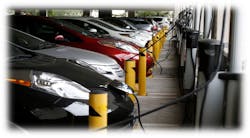Challenges During Electric Vehicle Fires in Open & Closed Parking Garages
First responders must acknowledge that communities consider them the experts in the field of whatever they mitigate on the streets. What constitutes an expert? A person who has extensive experience or knowledge in a specific field or discipline beyond that of a layperson.
As fire service professionals, we must understand the basics of how electric vehicles (EVs) work. In conjunction with that, we must understand how an EV fire can affect a parking garage.
EV fires’ extreme temperatures
We will see more and more EVs, particularly with the nation’s most ambitious climate control regulations to date: Two-thirds of new passenger cars and a quarter of new heavy-duty trucks that are sold in the United States are to be all-electric by 2032.
Concerns in the fire service about EVs and open and closed parking garages are increasing as a result of what has occurred in the United States and elsewhere in the world. These incidents involved hundreds of automobiles, injuries, severe structural damage and structure collapse. One video of an EV fire in a parking garage revealed that a significant fire that involved three vehicles developed in no more than three minutes. The fire was too large to extinguish with any portable fire extinguishers as soon as it self-vented from the vehicle of origin.
Per the NFPA Codebook, parking garages, or parking structures, can be located underground or aboveground. They usually are located in congested urban areas where large open parking lots aren’t feasible. They can be public or private and store automobiles, motorcycles, trucks and buses.
In parking garages, vehicles are parked right next to one another to save space. This becomes a combustible nightmare. We must get a handle on the fire within the first few minutes on arrival or we will lose the battle.
Early detection and quick preplanned attacks are critical to the outcome of these incidents, particularly when residences are attached to the parking garages.
Something else we must consider: Parking garages could be at risk of collapse as a result of the heavier weight of EVs compared with conventional automobiles.
As a reminder, fires that involve internal combustion engines, whether gasoline or diesel, are easier to battle than fires that involve EVs. Not to be overlooked: Many fire departments are limited in their response capabilities.
Further, the temperatures of fires that involve internal combustion engines can reach 1,500 degrees F; temperatures of fires that involve EVs can reach 4,500 degrees F and hotter. The temperature of an EV fire is a major concern for parking garages.
When concrete is exposed to temperatures that are hotter than 212 degrees F, the moisture in concrete turns to steam. If the temperature rises more rapidly than the steam can escape through the concrete matrix, the rising pressures exceed the strength of the concrete, and it begins to spall. This spalling can be explosive in extreme cases and can cause major damage, including collapse.
Charging station dangers
At least one private underground parking garage in Scranton, PA, and, apparently, numerous condominium associations in the United States banned the parking of EVs. There have been reports of spontaneous combustion of EVs in two underground parking garages that caused fires and structural damage. The good news: There are solutions for EVs in underground parking garages, but they aren’t simple nor cheap. Only with significant structural interventions can fires be contained reliably without the risk of significant secondary damage.
Among the solutions under consideration are CO2 and water mist concepts.
The goals of the NFPA’s Fire Protection Research Foundation’s Electric Vehicle Hazards in Parking Garages project are to quantify the fire hazard and spread characteristics of EVs to reform fire protection requirements of open and closed parking garages.
Although EV charging stations are popping up in open and closed parking garages, fire departments seemingly are the last to know about them.
Level 2 chargers (240 volts) are the type that are most commonly found at residential/commercial charging stations. The chargers’ plug usually offers about 40 amps of service.
The safety of the charging stations can be affected by wiring components as well as the competency and experience of the installer.
Water requirements
Given NFPA’s setting of four minutes from initial 9-1-1 call to the first engine’s arrival, some form of fire suppression must occur prior to the department’s arrival if a conflagration is to be avoided. NFPA doesn’t require a wet sprinkler system to be in place for open parking garages. They only are required to have a way of establishing a water supply (dry standpipe system), particularly on a multistory open parking garage.
The first on-scene units at a multistory garage must establish a secured water supply and have a way of advancing hoseline. The goal is to get the wet stuff on the red stuff as soon as possible to slow down the heat transfer to the batteries of other EVs to eliminate battery thermal runaway.
Besides water, alternative suppression measures that are available include fire blankets, cutting extinguishers, battery extinguishing systems and submerging tanks.
District walk-throughs
The bottom line is that we are the EV subject matter experts on scene. The only way that we can live up to this is by getting out into our first-alarm territory and learning our districts as well as learning the components of EVs and what makes them work. Walk-throughs of open and closed parking garages can affect how you manage your next EV fire within a parking garage structure.
When conducting walk-throughs, look for:
- Secured water supply (primary hydrant and secondary hydrants)
- Standpipe riser locations (wet and dry systems)
- Access on multistory parking garages (e.g., stairs, elevators, ramps, etc.)
- Estimating the stretch (utilize high-rise packs)
- Locations of Level 1/Level 2 EV charging stations
- Utility disconnects
- Sewer, storm drains, etc., for environmentally sensitive areas (because of contamination runoff)
Finally, remember that an EV has three distinct properties: chemical, electrical and thermal. All three can make for a bad day on your shift.
About the Author

Douglas LeValley
Douglas LeValley is a 42-year veteran of the fire service. He serves as division chief of special projects for the Seminole Tribe Fire Rescue Department, which is headquartered in Hollywood, FL. Previously, he served with Fort Lauderdale, FL, Fire Rescue and as a team leader for FEMA South Florida Task Force II USAR. LeValley is the founder of Advanced HazMat Management, which offers the Street Smart Chemistry course for hazmat team members. He is the author of “HAZMAT911.” LeValley has been a fire service educator for more than three decades. He has served as a consultant for the branches of the military in the discipline of downrange hazmat recon, identification and mitigation.
